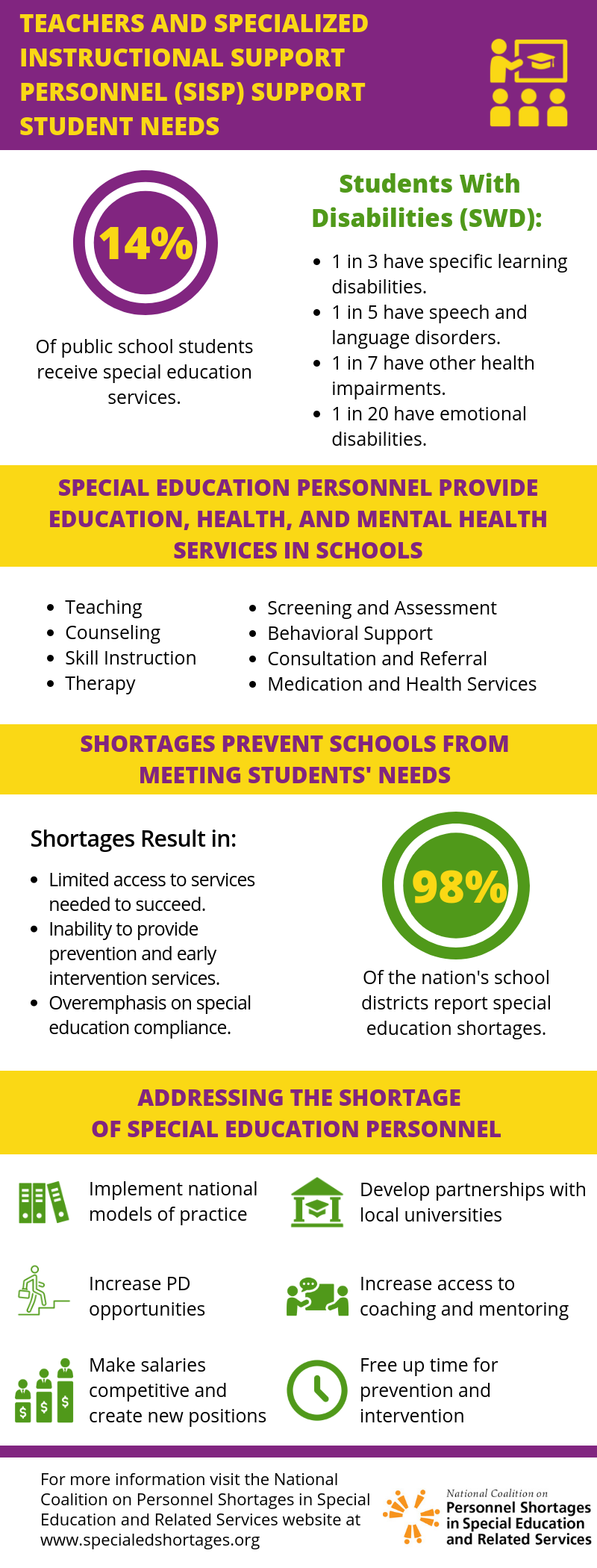Educating students with special needs should be a top priority, yet critical shortages of special education teachers and specialized instructional support personnel (SISP) exist in all regions of the country. The demand for these highly qualified professionals is increasing at a time when the Bureau of Labor Statistics indicates the shortages are “acute.” These shortages, as well as unfunded positions, impede the ability of students with disabilities to reach their full academic potential and hinder the work of districts to prepare all students to be college and career-ready.
Reasons Personnel Shortages Exist
Personnel shortages are the result of recruitment and retention challenges. There is both a shortage of professionals to fill available positions and a shortage of positions to meet the growing demand for services for America’s six million children and youth with disabilities who receive special education services.
Challenges Include:
- Poor working conditions which lead to professionals leaving special education (e.g., excessive paperwork, unmanageable caseloads/workloads, inadequate support, professional isolation)
- Insufficient funding for incentive programs designed to entice new graduate students and support them as they gain professional training (e.g., loan forgiveness, personnel preparation grants)
- Fewer qualified faculty and increasing higher education costs
- Limited supply of qualified professionals willing to work in certain communities (e.g., rural, high poverty, high crime)
- Credentialing barriers in some states limit opportunities for re-specialization, re-licensure, or alternative routes to licensure of otherwise qualified personnel
The Statistics:
- 54% of speech-language pathologists (SLPs) report shortages in their schools. SLPs from the western region of the United States (mountain and pacific states) are mostly likely to report shortages.1
- Overall, 15% of educational audiologists report shortages in their schools.2
- The national ratio of school psychologists (1:1182) is twice the recommended ratio (1:500–700). Further, there will be a shortage of almost 15,000 school psychologists in the United States by 2020.3
- The national ratio of students to school counselors (482:1) is almost twice the recommended ratio (250:1).4
- National data indicate 39% of public schools have a school nurse all day, every day, while another 35% of schools have a school nurse who works part time in one or more schools. Twenty-five percent of schools do not employ a school nurse.5
- National data indicate a critical 76% shortfall in the number of certified adapted physical education (APE) teachers needed within in the United States, with an estimated 20,087 additional APE teachers needed.6
- A recent survey performed only among schools for the deaf anticipates a demand for at least 500 teachers of the deaf in these schools over the next three years. However, the majority of deaf and hard of hearing students attend school in the mainstream, therefore this number greatly underestimates the number needed.7
- 49 states report a shortage of special education teachers/related service personnel for 2013–2014.8
- 82% of special educators and SISP from across the nation report that there are not enough professionals to meet the needs of students with disabilities.9
1 American Speech-Language-Hearing Association. (2018). 2018 Schools Survey report: SLP workforce/work conditions.
2 American Speech-Language-Hearing Association. (2018).
2018 Schools Survey summary report: Numbers and types of responses, educational audiologists.
3 National Association of School Psychologists
4 American School Counseling Association
5 National Association of School Nurses
6 Zhang, J. (2011). Quantitative analyses about market-and prevalence-based needs for adapted physical education teachers in the public schools in the United States. The Physical Educator, 68(3), 140–150.
7 Fischgrund, J. , & Tucker, J. , 2017, Future Needs at CEASD Schools for the Deaf. CEASD Annual Conference, St. Augustine, FL
8 2011 – 2012 Special Education/Related Services Personnel Shortages List
